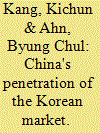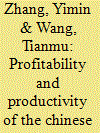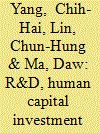|
|
|
Sort Order |
|
|
|
Items / Page
|
|
|
|
|
|
|
| Srl | Item |
| 1 |
ID:
099161


|
|
|
|
|
| Publication |
2010.
|
| Summary/Abstract |
China's penetration of the world market has been impressive. This paper uses highly disaggregated Korean import data (from 1992 to 2008) to examine China's penetration of the Korean market in the context of the composition of value (the extensive and intensive margins) and the product type (homogeneous and differentiated) in trade. The increase in Chinese imports has been attributed to the rapid increase in the import of new products (the extensive margin) and of existing products (the intensive margin). However, the growth rate of new products decelerated in the 2000s. The growth in the intensive margin was due to quantity, not price. Chinese imports to Korea did not improve over the period in terms of quality. Although Chinese products became cheaper, they were more differentiated over time. Welfare gains were realized through the expanded introduction of new products from China. However, much of the gains from Korea's Chinese product import boom were realized in earlier years (1992-2000) because even though imported products became more differentiated, the increase in the extensive margin was lower in more recent years (2001-2008).
|
|
|
|
|
|
|
|
|
|
|
|
|
|
|
|
| 2 |
ID:
099159


|
|
|
|
|
| Publication |
2010.
|
| Summary/Abstract |
Using data from 1986-2005, the present paper estimates the impact of direct knowledge spilled over from G-7 countries on China's economy. We use telephone line penetration rates and personnel flows to estimate the direct spillover effect. Our results show that direct knowledge spillovers through telecommunication networks and personnel flows are important components of international R&D spillovers in China. These direct channels of spillover effectively accelerate China's economic growth. Therefore, China should invest more in human capital and in its telecommunication network to enhance the absorptive capacity of direct R&D spillovers, and to increase communication with other nations, in particular the USA and Japan. More subsidies to domestic R&D research and purchase of intermediate goods will help to raise China's R&D intensity.
|
|
|
|
|
|
|
|
|
|
|
|
|
|
|
|
| 3 |
ID:
099166


|
|
|
|
|
| Publication |
2010.
|
| Summary/Abstract |
Migrant workers have become a major element of the labor force in Chinese cities, making important contributions to the economy while forming a socially disadvantaged group. Existing research on the relationship between the level of nutrition and health and income in China mainly focuses on farmers living in rural areas. Based on a Mincer equation and using a survey in Beijing, this paper examines the relationship between migrant workers' nutrition and health levels and their monthly incomes. We find that the nutrition intake and the body mass index have positive effects on income while duration of illness and daily working hours have negative effects. These conclusions imply that the Chinese Government should put more emphasis on improving migrant workers' well-being, including offering educational programs on nutrition and health, and enhancing medical insurance and the old-age insurance system.
|
|
|
|
|
|
|
|
|
|
|
|
|
|
|
|
| 4 |
ID:
099156


|
|
|
|
|
| Publication |
2010.
|
| Summary/Abstract |
In terms of the degree-of-freedom of bank loan decision-making, the ratio of loans of private enterprises and individuals to total loans is used to measure the development of China's financial intermediation. Applying generalized method of moments estimation developed for dynamic panel data models, the present paper finds that the effect of financial intermediation development on economic growth is positive and statistically significant when controlling for other variables, such as human capital, foreign direct investment, securitization and foreign trade. The empirical results indicate that the concept of the so-called Chinese counterexample in financial development is questionable. Financial system reforms, including encouraging banks to operate independently, reducing or eliminating mandatory loans, and making financial decision-making more market-oriented, are important for China's economic growth.
|
|
|
|
|
|
|
|
|
|
|
|
|
|
|
|
| 5 |
ID:
099165


|
|
|
|
|
| Publication |
2010.
|
| Summary/Abstract |
This paper discusses two methods of measuring net foreign assets(NFA): directly using the financial account and indirectly using the current account. The former method is found to be more accurate than the latter method. The paper also includes a detailed discussion of the valuation methodology. The results show that China's NFA are much lower than the cumulative current account surplus or the cumulative foreign exchange reserves. This leads to an underestimation of growth in foreign direct investment and an overestimation of the capacity of foreign exchange reserves to cope with possible withdrawals. Therefore, the Chinese Government should pay more attention to valuation issues to obtain more accurate measurement of NF A. Meanwhile, the Chinese monetary authority should relax its control on the foreign exchange settlement system, allow the private sector to hold a certain amount of foreign exchange, and encourage foreign assets to be denominated in RMB to solve structural problems, including entity and currency mismatch.
|
|
|
|
|
|
|
|
|
|
|
|
|
|
|
|
| 6 |
ID:
099154


|
|
|
|
|
| Publication |
2010.
|
| Summary/Abstract |
This paper considers the cost structure, profitability and productivity of the Chinese textile industry and estimates the impacts of RMB appreciation on this industry. Using data for 1999-2006, we found that the industry has suffered from very low profit margins and returns on capital. Because input prices have been increasing, particularly since 2001, generating profits has become more difficult for the industry. Nevertheless, the industry achieved substantial productivity growth over the period examined. Although at an inadequate level, the profitability of the industry did show some signs of improvement. As long as this trend continues, the industry could obtain a decent level of profitability. Since 2005, however, the industry has faced a new challenge: the appreciation of the RMB. Based on 2006 data, we estimated the maximum rate of RMB appreciation that the industry would be able to sustain to be approximately 5 percent a year.
|
|
|
|
|
|
|
|
|
|
|
|
|
|
|
|
| 7 |
ID:
099163


|
|
|
|
|
| Publication |
2010.
|
| Summary/Abstract |
Using firm-level panel data covering 2005-2007, the present paper examines the effects of R&D and human capital investment on productivity in China's electronics industry. It is found that both R&D and on-the-job training positively contribute to total factor productivity (TFP). Firms' investment in employees' health insurance and pensions, which are components of workers' compensation, generate a productivity-enhancing effect, supporting the efficiency wage hypothesis. The estimated impact of R&D on productivity varies among different forms of ownership, and foreign-owned enterprises experience higher R&D efficiency than state or private enterprises. After controlling for potential endogenous causality between TFP and R&D, the above findings remain unchanged. We also find that on-the-job training can improve the quality of human capital and is helpful in promoting productivity. Therefore, establishing indigenous technological capability through various technological sources is quite important, and the government should devote further effort to investing in human capital.
|
|
|
|
|
|
|
|
|
|
|
|
|
|
|
|
|
|
|
|
|